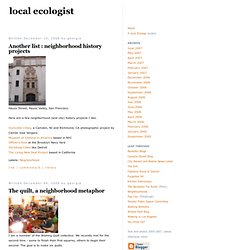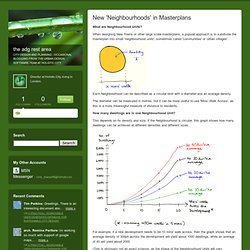

Local ecologist. Written October 09, 2006 by georgia Ode to the neighbor(hood) Note: The original version of this post first appeared on 10/9/06.

This version was made on 10/10/06. Silver, solar-powered, musical bus at Telegraph and Dwight, 10/8/06Double-click on the image to read the text on the far left.In episode 318 of This American Life, a segment about a bad neighbor was accompanied by the song "I Got to Get Away" by Dave Parker. According to Jay Walljasper, guest editor of Terrain on "The Music of It All," Music, more than any other American art form or entertainment industry, truly reflects the rich geographic diversity of our country....Why is a sense of place usually an ingredient in the best music? The sighting of the musical bus, the special issue of Terrain, the airing of the neighbor segment on public radio as well as a posting on Walking Berkeley about entertainment fliers sparked an internet search for songs related to neighbor and neighborhood. Won't you be my neighbor? Labels: Neighborhood. The adg rest area: New 'Neighbourhoods' in Masterplans.
What are Neighbourhood Units?

When designing New Towns or other large scale masterplans, a popular approach is to subdivide the masterplan into small 'neighbourhood units', sometimes called 'communities' or 'urban villages'. Each Neighbourhood can be described as a circular blob with a diameter and an average density. The diameter can be measured in metres, but it can be more useful to use 'Mins' Walk Across', as this is a more meaningful measure of distance to residents. How many dwellings are in one Neighbourhood Unit? This depends on its density and size. For example, if a new development needs to be 10 mins' walk across, then the graph shows that an average density of 30dph across the development will yield about 1000 dwellings, while an average of 40 will yield about 2000.
(This is obviously not an exact science, as the shape of the Neighbourhood Units will vary according to local constraints, and is unlikely to be exactly circular.) NB. Projects » NEW NEIGHBOURHOODS. Project: Rural Settlement, New Community, Sustainable Neighborhood Unit T-six Role: Charrette Facilitation, Master Plan, Approvals Client: Oko Properties Ltd. Uses: Residential, Live-Work, Mixed Use, Civic Mike Holmes is a Canadian celebrity with growing international acclaim. Famous as Canada’s Most Trusted Contractor, Mike is best known for his renovation rescues on the international hit television series Holmes on HomesTM. Wind Walk is Mike’s first venture into homebuilding at the community scale and Holmes Communities represent the culmination of his career-long crusade against the poor quality that plagues the home building and development industries.
T-Six is proud to have led the design for the first Holmes Community and brought to the project our own expertise in, and passion for, sustainable urbanism – particularly within an Alberta context. The Town Planning Review, Vol. 24, No. 4 (Jan., 1954), pp. 256-270. Neighbourhood unit. The concept of the neighbourhood unit, crystallised from the prevailing social and intellectual attitudes of the early 1900s by Clarence Perry, is an early diagrammatic planning model for residential development in metropolitan areas.[1] It was designed by Perry to act as a framework for urban planners attempting to design functional, self-contained and desirable neighbourhoods in the early 20th century in industrialising cities.[2] It continues to be utilised (albeit in progressive and adapted ways, see New Urbanism), as a means of ordering and organising new residential communities in a way which satisfies contemporary "social, administrative and service requirements for satisfactory urban existence".[1] History[edit] While Perry’s name is most commonly associated with the notion of the neighbourhood unit, the idea of "re-defining and re-planning the city of the basis of neighbourhoods",[5] was not Perry’s in isolation.

William E. Principles[edit] Urban application[edit] Criticism[edit] Neighborhood Boundaries. Download original report (pdf) Prepared by Jerrold R.

Allaire The concept of the city as a whole, containing a group of component neighborhoods is not new, nor is discussion of neighborhood related problems a recent advent to planners, sociologists, traffic engineers, realtors and others closely involved in the patterns of urban land use. In a paper presented to American City Planning Institute (the forerunner of the American Institute of Planners), Henry Wright said about neighborhood planning:1 The subject bristles with opportunities for research and discussion. Mr. Thirty years later, the subject still "bristles with opportunities for research and discussion. " The main purpose of this report is to gather in a single reference the most important methods of neighborhood delineation and to examine how and to what extent they are used in the field.
Background 1. 2.